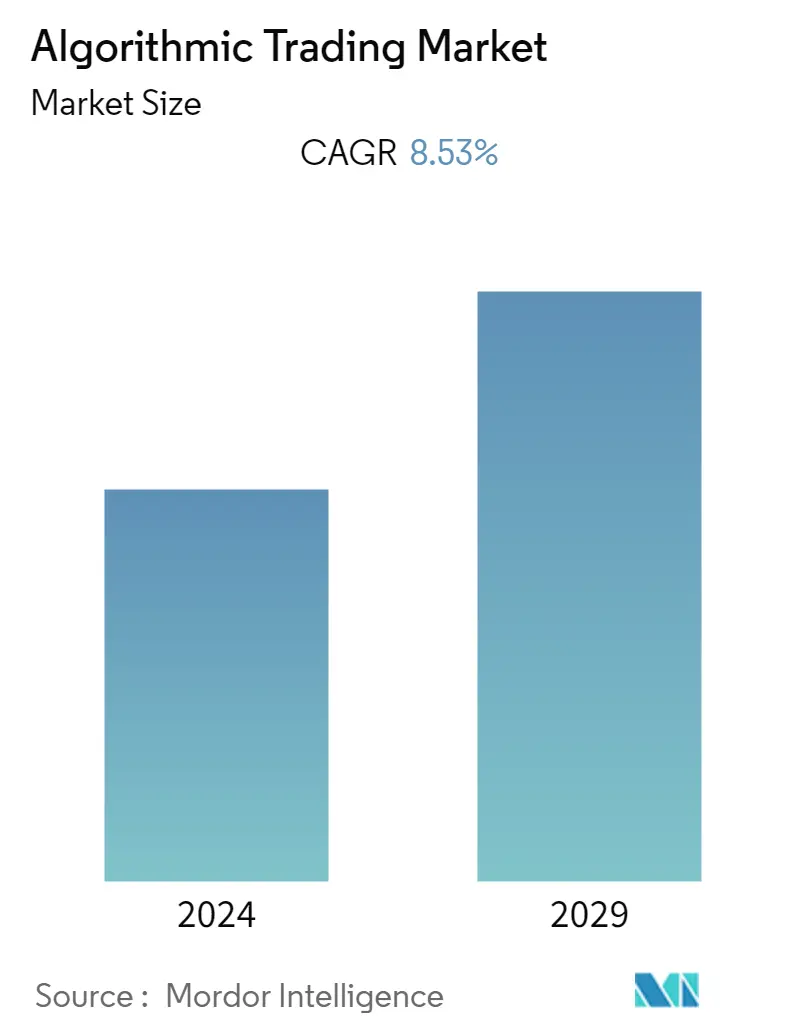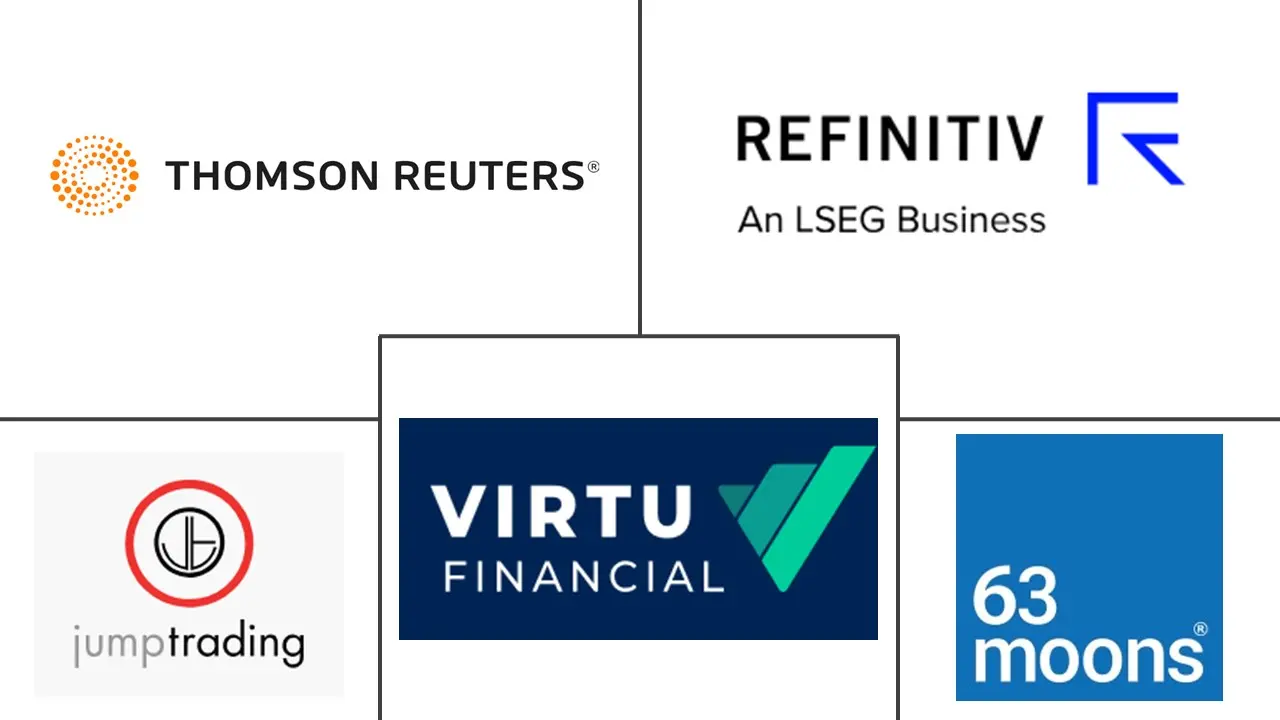Market Size of Algorithmic Trading Industry

| Study Period | 2019 - 2029 |
| Base Year For Estimation | 2023 |
| CAGR | 8.53 % |
| Fastest Growing Market | Asia Pacific |
| Largest Market | North America |
| Market Concentration | Low |
Major Players
*Disclaimer: Major Players sorted in no particular order |
Algorithmic Trading Market Analysis
The Algorithmic Trading Market was valued at USD 14.42 billion in the current year and is expected to register a CAGR of 8.53%, reaching USD 23.74 billion in five years. Traders have traditionally used market surveillance technology to keep track of their trading operations and investment portfolios. Applications with built-in intelligence, like algorithmic trading, can explore the market for various opportunities based on the yield and other parameters the user specifies.
- The need for the algorithmic trading industry is anticipated to be driven by favorable governmental rules, rising demand for quick, reliable, and efficient order execution, increasing demand for market surveillance, and declining transaction costs. Large brokerage firms and institutional investors use algorithmic trading to reduce the expenses of bulk trading. Additionally, it is anticipated that the development of artificial intelligence (AI) and financial service algorithms will create attractive market expansion opportunities. A rise in the demand for cloud-based solutions is also anticipated to support the growth of the algorithmic trading market.
- The technological revolution has altered how one can interact with the world and do business. But, far from reaching maturity, the revolution continues to unfold, revealing even more disruptive technologies and approaches capable of disrupting entire industries and spawning significantly new business models. Advanced and intelligent trading systems have evolved with markets and technological advances in recent years. These systems have become increasingly popular in recent years as they enable different levels of automated trading.
- Since the introduction of matching engines in modern exchanges, algorithmic trading has been used globally. By removing human restrictions, such technological advancements have enhanced the capacity of markets to process orders and trades. As a result, the studied market's timeline shifted from seconds to milliseconds, and market surveillance was transferred from the trading pit to computers. Whether conducted by a government or an exchange, market surveillance safeguards market integrity and protects participants from unethical behavior.
- While algorithmic trading has its advantages, it can also amplify the negative trends in the market studied by causing crashes (so-called "flash crashes") and immediate loss of liquidity. The instant loss of liquidity can restrain market growth.
- The COVID-19 pandemic led to increased dependence on technologies owing to the global lockdowns. The volatile market conditions, high trading volume, and drive for rapid digital transformation to cope with the remote working environment have all contributed to the uptick in algorithmic trading.
Algorithmic Trading Industry Segmentation
Algorithmic trading, also known as automated trading, algo-trading, or black-box trading, is a method of implementing trade orders with automated pre-programmed trading instructions. Considering variables like volume, price, and time, the programs send small slices of the order to the market over a period.
The Algorithmic Trading market is segmented by types of traders (institutional investors, retail investors, long-term traders, short-term traders), by component (solutions (platforms, software tools), services), by deployment (on-cloud, on-premise), by organization size (small and medium enterprises, large enterprises), by geography (North America, Europe, Asia Pacific, Latin America, Middle East, and Africa).
The market sizes and forecasts are provided in terms of value in USD for all the above segments.
| By Types of Traders | |
| Institutional Investors | |
| Retail Investors | |
| Long-term Traders | |
| Short-term Traders |
| By Component | ||||
| ||||
| Services |
| By Deployment | |
| On-cloud | |
| On-premise |
| By Organization Size | |
| Small and Medium Enterprises | |
| Large Enterprises |
| By Geography | |
| North America | |
| Europe | |
| Asia Pacific | |
| Latin America | |
| Middle East and Africa |
Algorithmic Trading Market Size Summary
The algorithmic trading market is experiencing significant growth, driven by advancements in technology and increasing demand for efficient trading solutions. This market leverages intelligent applications to identify trading opportunities based on specified parameters, offering benefits such as quick and reliable order execution, reduced transaction costs, and enhanced market surveillance. The rise of artificial intelligence and cloud-based solutions is further propelling market expansion, as these technologies provide scalable, cost-effective, and efficient trading processes. The shift towards cloud deployment is particularly notable, as it allows traders to automate processes, maintain trade data, and test new strategies without substantial upfront investments. This transition is supported by the growing adoption of hybrid cloud solutions among enterprises, which offer business agility and continuous innovation.
North America is poised to dominate the algorithmic trading market, supported by substantial investments in trading technologies and a robust regulatory framework. The region's market growth is fueled by the increasing adoption of algorithmic trading strategies by institutional investors, including asset management firms and hedge funds, who seek to enhance trading efficiency and manage risk. The market is highly fragmented, with key players like Thomson Reuters, Jump Trading LLC, and Virtu Financial Inc. actively engaging in partnerships and acquisitions to strengthen their offerings. Recent developments, such as Virtu Financial's launch of Alert+ and Refinitiv's digital onboarding solution, highlight the ongoing innovation and strategic collaborations shaping the market landscape.
Algorithmic Trading Market Size - Table of Contents
-
1. MARKET INSIGHTS
-
1.1 Market Overview
-
1.2 Industry Attractiveness - Porter's Five Forces Analysis
-
1.2.1 Bargaining Power of Suppliers
-
1.2.2 Bargaining Power of Buyers/Consumers
-
1.2.3 Threat of New Entrants
-
1.2.4 Threat of Substitute Products
-
1.2.5 Intensity of Competitive Rivalry
-
-
1.3 Impact of COVID-19 on the Market
-
1.4 Technology Snapshot
-
1.4.1 Algorithmic Trading Strategies
-
1.4.1.1 Momentum Trading
-
1.4.1.2 Arbitrage Trading
-
1.4.1.3 Trend Following
-
1.4.1.4 Execution-based Strategies
-
1.4.1.5 Sentiment Analysis
-
1.4.1.6 Index-fund Rebalancing
-
1.4.1.7 Mathematical Model-based Strategies
-
1.4.1.8 Other Algorithmic Trading Strategies
-
-
-
-
2. MARKET SEGMENTATION
-
2.1 By Types of Traders
-
2.1.1 Institutional Investors
-
2.1.2 Retail Investors
-
2.1.3 Long-term Traders
-
2.1.4 Short-term Traders
-
-
2.2 By Component
-
2.2.1 Solutions
-
2.2.1.1 Platforms
-
2.2.1.2 Software Tools
-
-
2.2.2 Services
-
-
2.3 By Deployment
-
2.3.1 On-cloud
-
2.3.2 On-premise
-
-
2.4 By Organization Size
-
2.4.1 Small and Medium Enterprises
-
2.4.2 Large Enterprises
-
-
2.5 By Geography
-
2.5.1 North America
-
2.5.2 Europe
-
2.5.3 Asia Pacific
-
2.5.4 Latin America
-
2.5.5 Middle East and Africa
-
-
Algorithmic Trading Market Size FAQs
What is the current Algorithmic Trading Market size?
The Algorithmic Trading Market is projected to register a CAGR of 8.53% during the forecast period (2024-2029)
Who are the key players in Algorithmic Trading Market?
Thomson Reuters, Jump Trading LLC, Refinitiv Ltd, 63 Moons Technologies Limited and Virtu Financial Inc. are the major companies operating in the Algorithmic Trading Market.

